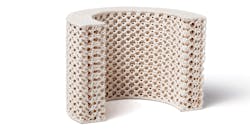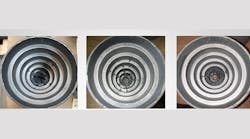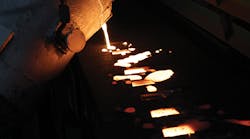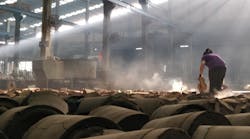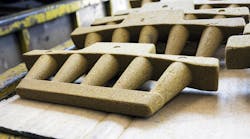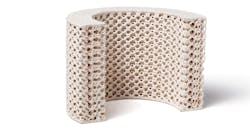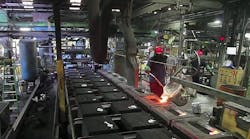However, the temperature of the working environment and the temperature of the no-bake patterns also can have a significant effect. In northern reaches of the U.S. and Canada many foundry operations implement countermeasures to ward off the effects of cold temperatures. It is not uncommon to see pattern pre-heaters being used during the colder months of the year.
It also is common also to see foundries adding a “positive bias” to the start-up programming for their catalyst-pumping systems. This additional charge of catalyst compensates for effects of cold equipment within the process. It is important to remember that small amounts of heat are usually beneficial for most small- to medium-sized molding operations, but this can be detrimental when over applied.
Shifting sand variables also may have a notable effect on the speed of a no-bake molding process. One of the most commonly overlooked and misunderstood sand-system variable is ADV (acid demand value). ADV is an indirect measure of the acidic or basic materials contained within the raw molding sand before the addition of chemicals. If allowed to increase or decrease in an unchecked manner, changes in ADV can shut down a molding line completely.
It is a common practice for foundries to use a blend of new sand, mechanically reclaimed sand, and/or thermally reclaimed sand as the foundation for their no-bake molding operations. Each of these sands will have their own ADV values. As the percentage of each sand in the blend changes, so does the ADV. In both mechanically and thermally reclaimed sands the ADV can change dramatically based on the level of contaminants or “tramp” materials.
It is not uncommon to watch the ADV values of mechanically reclaimed sand double or halve in a short period of time due the excessive build-up of oxides, natural impurities, and residual binder/catalyst levels. The ADV values associated with thermally reclaimed sands can increase/decrease by a factor of three or four simply due to the calcination of tramp materials (spent riser sleeves, core and mold adhesives, residual refractory materials from coatings, etc.) Sand reclamation systems should not be a repository for floor sweepings and other unwanted process related materials.
Most no-bake molding operations attempt to control the speed of production through chemistry, equipment, and computerization/programming. The cure speed associated with core or mold production can vary based on several resin-related factors, including: the reactivity of the resin system; the amount of resin being used; the ratio of part I to part II, where appropriate; the amount of catalyst or co-reactant being used; and the strength of the catalyst or co-reactant in use.
Coupling chemical binder systems that meet very tight specifications with the appropriate equipment and engineering controls (pumps, sensors, programing) may result in highly automated and repeatable mold-making capabilities. Not doing so subjects the process to high levels of unwanted variation.
In summary, no-bake molding operations are subject to three groups of process variables that control cure speed. Controlling the relevant temperature-related variables, sand-related variables, and chemistry-related variables will improve both productivity and quality. Using a high-quality sand heater to control the temperature of the sand going into the mixer is a great place to start. However, continuous improvement in other areas of the process is required to obtain true “process control.”
Join the Conversation. Email Your Questions for ASK Chemicals
Share your insights, opinions, and elaborate on the questions and the experts' answer(s). You must be logged in to the website in order to post your comments.
